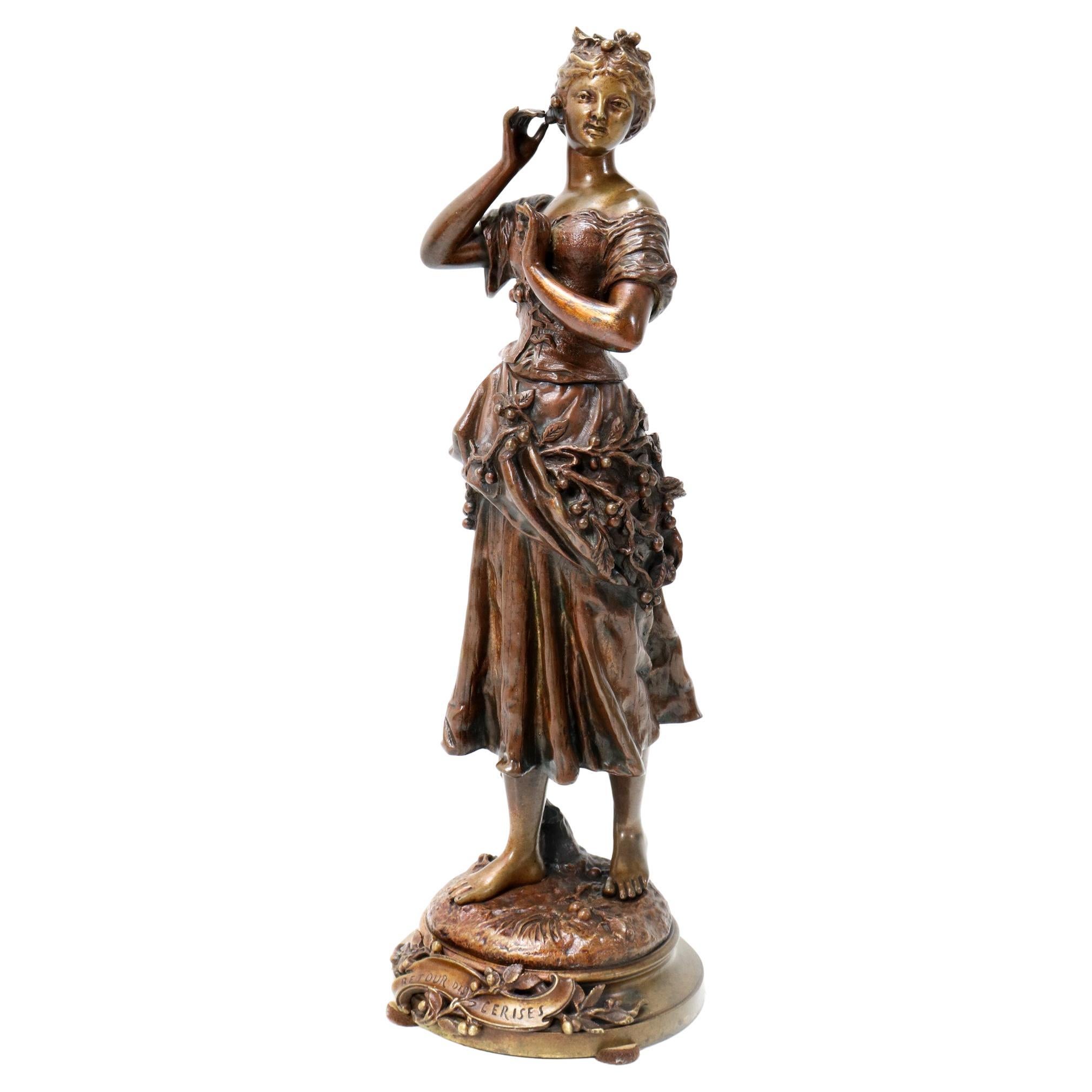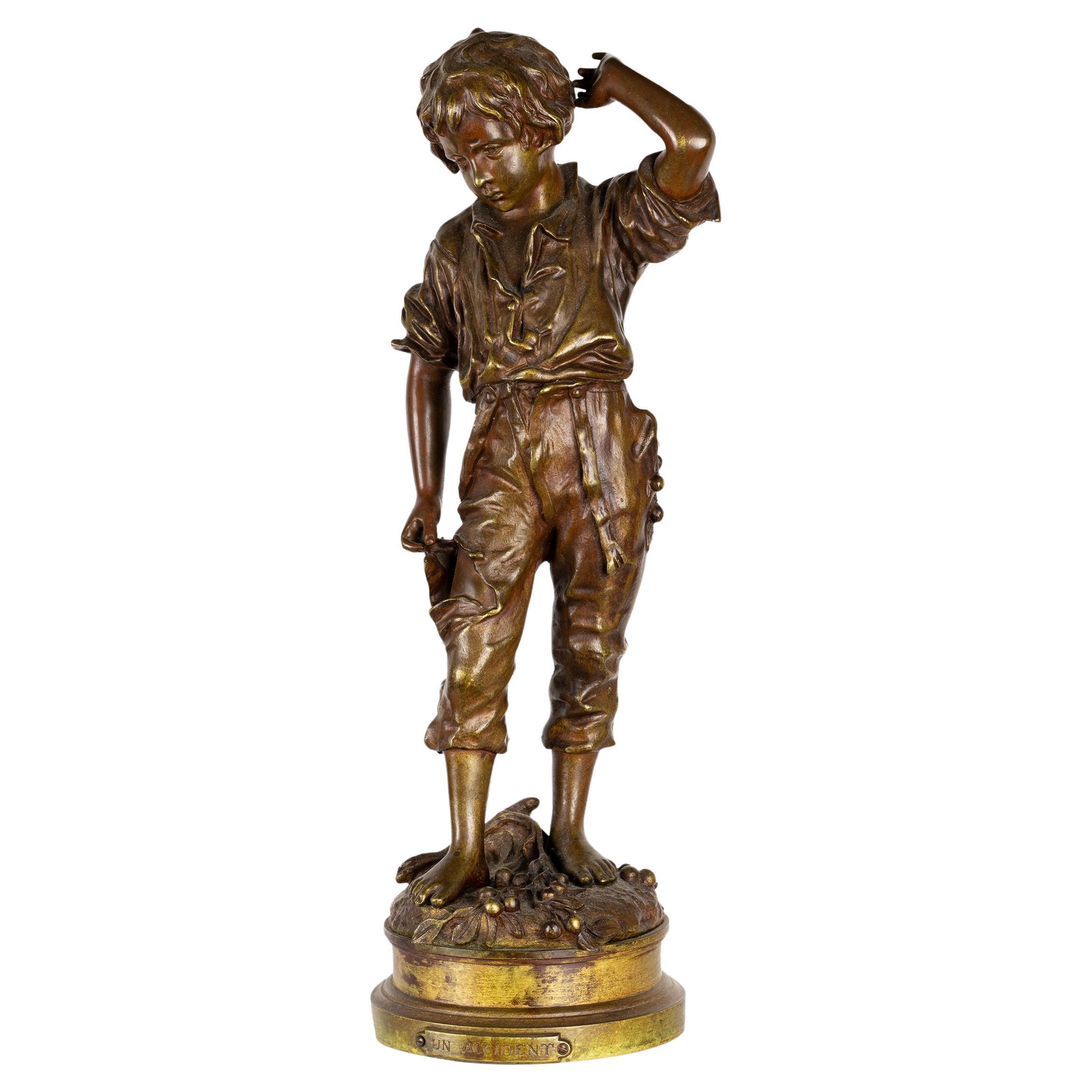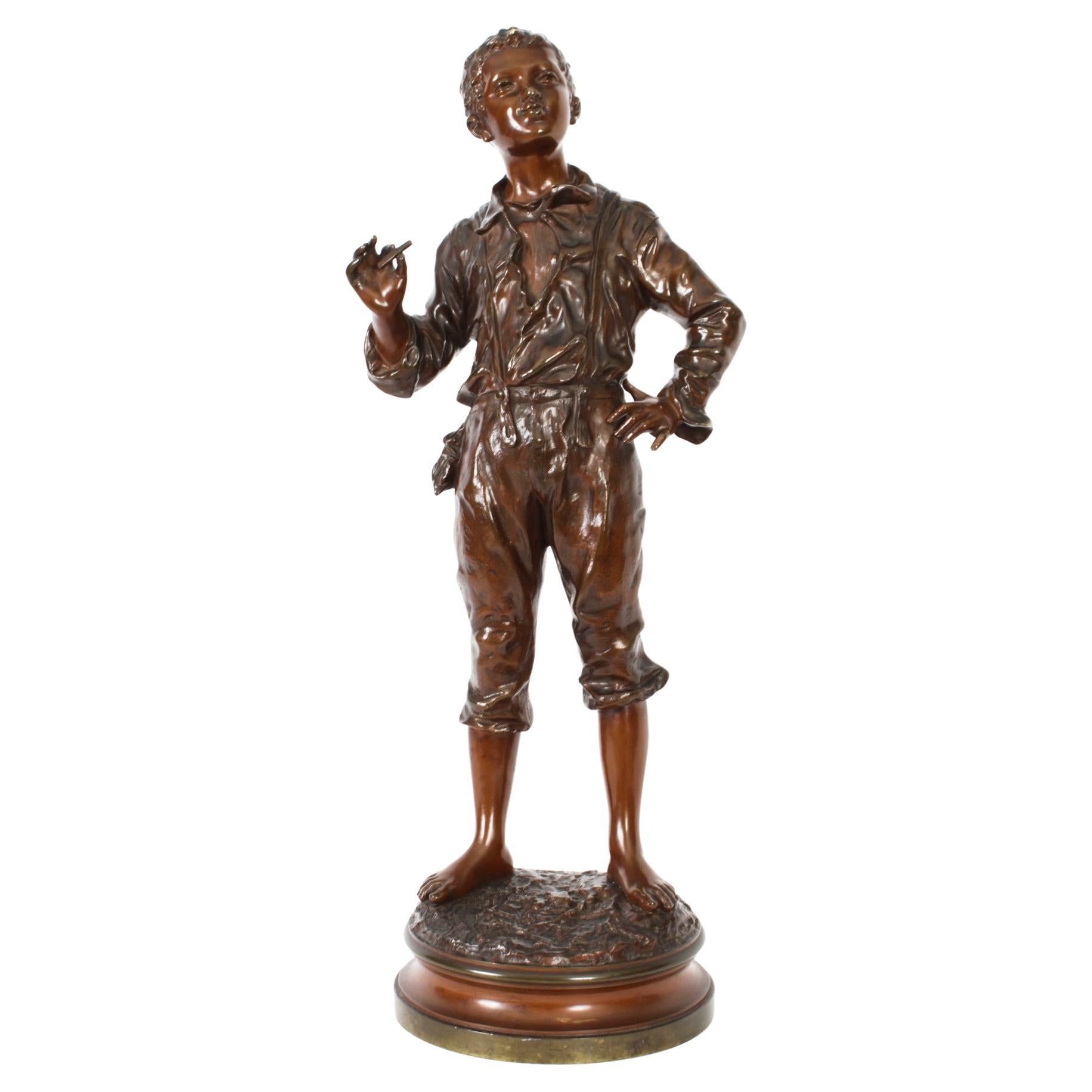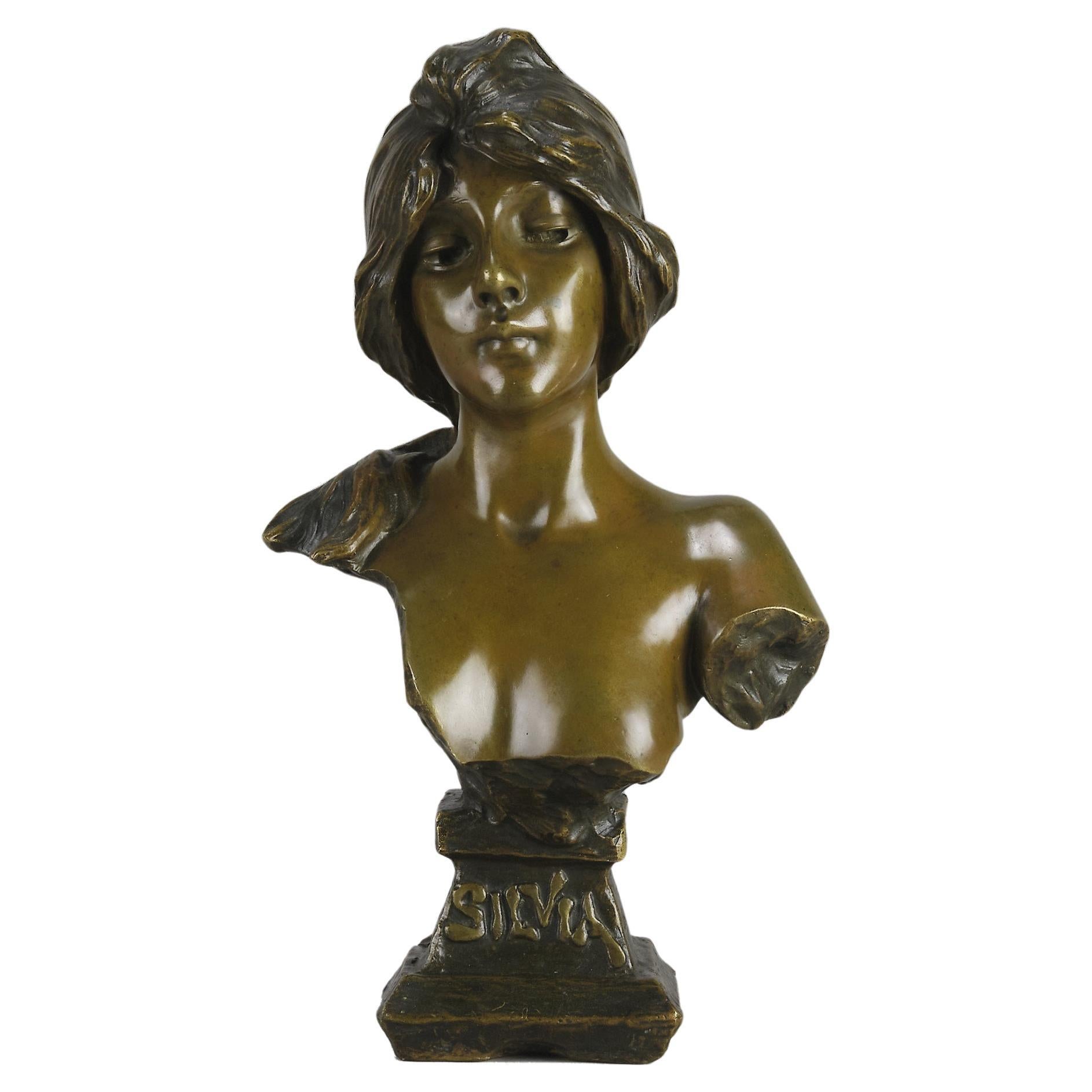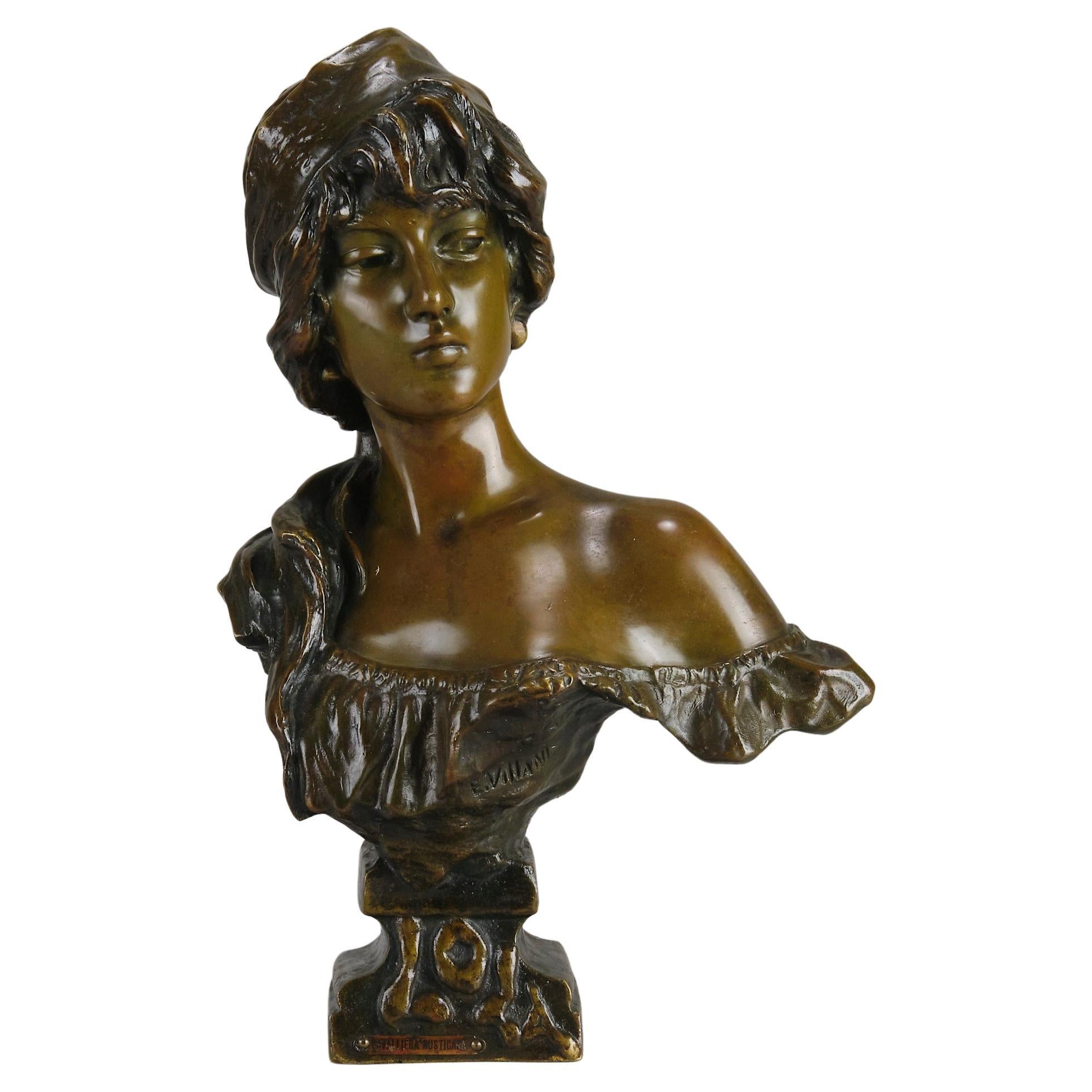Items Similar to Late 19th Century Art Nouveau Bronze Entitled "Broken Jug" by Charles Anfrie
Want more images or videos?
Request additional images or videos from the seller
1 of 12
Late 19th Century Art Nouveau Bronze Entitled "Broken Jug" by Charles Anfrie
About the Item
A very fine late 19th century bronze figure of a young lad dressed in period attire holding a broken jug, with excellent rich brown patina and fabulous hand finished surface detail, signed & titled
ADDITIONAL INFORMATION
Height: 20 cm
Condition: excellent original condition
Circa: 1890
Materials: Bronze
SKU: 8279
ABOUT
Charles Anfrie (French, 1833 ~ 1905) was a French artist specialising mainly in the human form.
- Creator:Charles Anfrie (Artist)
- Dimensions:Height: 7.88 in (20 cm)Width: 0 in (0.01 mm)Depth: 0 in (0.01 mm)
- Style:Art Nouveau (Of the Period)
- Materials and Techniques:Bronze,Cast
- Place of Origin:
- Period:
- Date of Manufacture:1890
- Condition:Wear consistent with age and use. Excellent. Excellent Original Condition Please note that our items are genuine antiques with considerable age. It is therefore normal that they will show some signs of wear and handling to the surface.
- Seller Location:London, GB
- Reference Number:
About the Seller
5.0
Gold Seller
These expertly vetted sellers are highly rated and consistently exceed customer expectations.
Established in 1936
1stDibs seller since 2017
63 sales on 1stDibs
Typical response time: <1 hour
- ShippingRetrieving quote...Ships From: London, United Kingdom
- Return PolicyA return for this item may be initiated within 10 days of delivery.
More From This SellerView All
- Late 19th Century Art Nouveau Bust Entitled "Cendrillon" by Emmanuel VillanisBy Emmanuel VillanisLocated in London, GBAn attractive late 19th Century Art Nouveau French bronze bust exhibiting deep multi-hued patination and excellent detail. The beautiful character wearing a head dress and a loosely draped blouse representing ’Cinderella’ from the famous French opera. The bronze is signed E Villanis and titled to the fore on its integral bronze base. ADDITIONAL INFORMATION Height: 30 cm Width: 19 cm Depth: 12 cm Condition: excellent original condition Circa: 1890 Materials: Bronze Book Ref: Emmanuel Villanis by Josje Hortulanus-de Mik Page No: 35 SKU: 8773 ABOUT Villanis Cendrillon Emmanuel Villanis was an industrious man. He is believed to have created some 200 to 250 pieces. His oeuvre pre-eminently consisted of busts and full body statues...Category
Antique 19th Century French Art Nouveau Figurative Sculptures
MaterialsBronze
- Late 19th Century Art Nouveau Bust entitled "Silvia" by Emmanuel VillanisBy Emmanuel VillanisLocated in London, GBA very fine late 19th century French bronze bust of an attractive classical maiden modelled in the Art Nouveau style, with fabulous multi hued patination of brown and a subtle green, accentuating the excellent hand finished detail. Signed E Villanis, with Societe des Bronzes foundry seal, numbered and with raised title to the fore. ADDITIONAL INFORMATION Height: 28 cm Width: 16 cm Depth: 10 cm Condition: Excellent Original Condition circa: 1890 Materials: Bronze Book Ref: Emmanuel Villanis by Josje Hortulanus-de Mik Page No: 79 SKU: 8775 ABOUT Sylvia Ballet - Silvia Sylvia, (the spelling is different in french) is a classical ballet. It features a nondescript mythical setting and a late nineteenth-century score, in which it's themes correlate to giving it a more classical feel, however, it was quite revolutionary for its time. The score was and still is recognized for its greatness. Delibes' work is certainly the best appreciated aspect of the ballet for its innovation, creativity, and maturity. Frederick Ashton's choreography complements the music very well in this respect, staying true to the spirit of the original production while incorporating modern techniques and adding his own unique touch. The ballet itself follows Sylvia who is a loyal follower of Diana (the goddess of the hunting and chassitity). The story starts with Sylvia being stalked by the diety Eros. When she discovers this they fire their bows at each other respectively. However only Eros's shot is true and wounds Sylvia. This is where she is kidnapped by an unknown assailant later revealed to be Orion. Sylvia escapes the caves of Orion by getting her captor intoxicated and pleading to Eros to rescue her. When he begrudgingly rescues her he takes her to the temple of Diana where her love awaits. This leads her to repeal her oath of Chassity taken as a follower of Diana. Emmanuel Villanis Emmanuel Villanis was an industrious man. He is believed to have created some 200 to 250 pieces. His oeuvre pre-eminently consisted of busts and full body statues. Most of these were manufactured in bronze, but there are also models in white metal and terra cotta. Different patinas were used. The bronzes were mainly cast by the Societé de Bronzes de Paris and can be recognised by the round stamp...Category
Antique Late 19th Century French Art Nouveau Busts
MaterialsBronze
- Late 19th Century Art Nouveau Bust Entitled "Lola" by Emmanuel VillanisBy Emmanuel VillanisLocated in London, GBStunning Art Nouveau bronze bust depicting the character "Lola" modelled in the midst of an inquisitive look. The study has a multi hued patination of colours that accentuate the very fine hand chased surface detail. Signed ?E Villanis...Category
Antique 19th Century French Art Nouveau Busts
MaterialsBronze
- 19th Century Art Nouveau Bronze Bust Entitled "Bohémienne" by Emmanuel VillanisBy Emmanuel VillanisLocated in London, GBCaptivating late 19th century French bronze bust of a beautiful woman, enhanced by the variegated rich brown patination and excellent tactile surface detail, raised on an integral bronze base with raised title to the fore. Signed ?E Villanis and further raised on a breche griotte stepped and shaped marble plinth ADDITIONAL INFORMATION Height: 33 cm Width: 16 cm Depth: 11 cm Condition: Excellent Original Condition circa: 1890 Materials: Bronze Book Ref: Emmanuel Villanis by Josje Hortulanus-de Mik Page No: 17 SKU: 8616 ABOUT Puccini's Opera - La Bohème SYNOPSIS - A group of friends are living a Bohemian life in Paris and trying to make their livings creating art. Rodolfo, the writer, falls in love with the seamstress, Mimi, while Marcello, the painter, and Musetta, the singer, are the on-and-off-again couple by their sides. When the four are happy, they spend their time celebrating life and love. However, Mimi is revealed to be very ill, and Rodolfo struggles to come to terms with the fact that she will inevitably die. Rodolfo and Mimi break up, and months later, Musetta discovers Mimi extremely sick and close to death. She brings Mimi to Rodolfo and Marcello's apartment. Rodolfo immediately takes her in and tries to nurse her back to health, but he is too late. Almost as soon as the two are reunited and have professed their love for one another, Mimi succumbs to her illness and dies. Emmanuel Villanis Emmanuel Villanis was an industrious man. He is believed to have created some 200 to 250 pieces. His oeuvre pre-eminently consisted of busts and full body statues. Most of these were manufactured in bronze, but there are also models in white metal and terra cotta. Different patinas were used. The bronzes were mainly cast by the Societé de Bronzes de Paris and can be recognised by the round stamp...Category
Antique Late 19th Century French Art Nouveau Busts
MaterialsMarble, Bronze
- 19th Century Art Nouveau Bronze Entitled "Venus & Cupid" by Jean Sul-AbadieBy Jean AbadieLocated in London, GBA very fine bronze study of Venus taking an arrow from Cupid her son, who at times would shoot his arrows without meaning or reason into the hearts of men, igniting their desire. Exhibiting excellent rich brown patina and good detail, signed Sul Abadie and stamped. Additional information Height: 93 cm Condition: excellent condition Circa: 1885 Materials: bronze & marble SKU: 4979 ABOUT Jean Sul-Abadie Jean Sul-Abadie (Born 1850 ~ Died 15th April 1890) was a French artist, a pupil of Jouffroy and Falguière. Specialising in bronze sculpting in the Art Nouveau style. He made his Salon debut in 1872. Cupid & Venus Different tales exist about the origin of Venus and Cupid. Some say that Venus, the goddess of love and beauty, had a love affair with Mars, the god of war. Out of this relationship, Cupid was born. In the following painting you see Venus with Mars, who is being disarmed by Cupid. Cupid has attributes from both of his parents. Like his mother he is considered to be the god of love, or more precisely, the god of falling in love. He is portrayed as an innocent little child with bow and arrows. He shoots arrows to the heart, and awakening a love that you’re powerless to resist. In classical mythology, Cupid (Latin Cupido, meaning “desire”) is the god of desire, erotic love, attraction and affection. He is often portrayed as the son of the love goddess Venus and the war god Mars, and is known in Latin also as Amor (“Love”). His Greek counterpart is Eros. Although Eros is in Classical Greek art as a slender winged youth, during the Hellenistic period, he was increasingly portrayed as a chubby boy. During this time, his iconography acquired the bow and arrow that represent his source of power: a person, or even a deity, who is shot by Cupid’s arrow is filled with uncontrollable desire. In myths, Cupid is a minor character who serves mostly to set the plot in motion. He is a main character only in the tale of Cupid and Psyche, when wounded by his own weapons he experiences the ordeal of love. Although other extended stories are not told about him, his tradition is rich in poetic themes and visual scenarios, such as “Love conquers all” and the retaliatory punishment or torture of Cupid. In art, Cupid often appears in multiples as the Amores, or amoriniin the later terminology of art history, the equivalent of the Greek erotes. Cupids are a frequent motif of both Roman art and later Western art of the classical tradition. In the 15th century, the iconography of Cupid starts to become indistinguishable from the putto. Cupid continued to be a popular figure in the Middle Ages, when under Christian influence he often had a dual nature as Heavenly and Earthly love. In the Renaissance, a renewed interest in classical philosophy endowed him with complex allegorical meanings. In contemporary popular culture, Cupid is shown drawing his bow to inspire romantic love, often as an icon of Valentine’s Day. Venus is the Roman goddess whose functions encompassed love, beauty, sex, fertility, prosperity, victory, and desire. In Roman mythology, she was the mother of the Roman people through her son, Aeneas, who survived the fall of Troy...Category
Antique Late 19th Century French Art Nouveau Figurative Sculptures
MaterialsBreccia Marble, Bronze
- Late-19th Century French Animalier Bronze Entitled "Turning Whippet" by L MayerBy Louis MayerLocated in London, GBDelightful late19th century French Animaliers bronze study of a turning whippet looking around in an attitude to play, with rich brown colour and fine hand chased surface detail. Sig...Category
Antique 19th Century French Art Nouveau Animal Sculptures
MaterialsMarble, Griotte Marble, Bronze
You May Also Like
- Late 19th Century Art Nouveau Bronze Retour Des Cerises by Charles AnfrieBy Charles AnfrieLocated in Amsterdam, NLStunning and rare Late 19th Century Art Nouveau sculpture. Design by Charles Anfrie. Striking French design from the 1890s. This wonderful Late 19th Century Art Nouveau sculpture by Charles Anfrie is executed in patinated bronze and signed at the base with Retour Des Cerises. This attractive young girl walks away happy after picking...Category
Antique 1890s French Art Nouveau Figurative Sculptures
MaterialsBronze
- 19th Century French Bronze Sculpture entitled An accident by Charles AnfrieBy Vrai Bronze B.D., Charles AnfrieLocated in Lisbon, PTA Charles Anfrie (Catalan sculptor Charles Anfrie, 1833-1905) bronze statue of a boy “C. Anfrie” signed with “ Vrai Bronze Garanti. Paris. BL” caster seal and titled 'Un accident' ...Category
Antique 19th Century French Napoleon III Figurative Sculptures
MaterialsBronze
- Antique Bronze Street Urchin by Charles Anfrie, 1833-1905', 19th CenturyBy Charles AnfrieLocated in London, GBThis is a large Spanish bronze sculpture of a street urchin by the renowned Catalan sculptor Charles Anfrie, 1833-1905 and Circa 1890 in date. The s...Category
Antique 1890s Spanish Figurative Sculptures
MaterialsBronze
- Late 19th Century Art Nouveau Bronze Vase by Marcel DebutBy Marcel DebutLocated in Paris, FRLarge, bronze amphora vase with green, brown, and yellow patination. The front of the paunch is decorated with a naiad, lying on waves and surrounded by aquatic plants. On the other ...Category
Antique Late 19th Century French Art Nouveau Vases
MaterialsBronze
- A Patinated Bronze Figure of a Marine, after the original by Charles AnfrieBy Charles AnfrieLocated in 263-0031, JPThe French sculptor Charles Anfrie (1833-1905) created a number of pieces on martial themes. This work, bearing a cartouche reading “Après le Combat,” shows what I surmise is a Frenc...Category
Antique Early 19th Century French Figurative Sculptures
MaterialsBronze
- Late 19th Century Bronze Sculpture Entitled "Marquerite" Signed P. DuboisBy Paul DuboisLocated in New York, NYA wonderful late 19th century bronze sculpture entitled "Marquerite" Signed P. Dubois The bronze depicting a beautiful woman playing the harp. Paul Dubois was born on the 18...Category
Antique Late 19th Century French Belle Époque Figurative Sculptures
MaterialsBronze
Recently Viewed
View AllMore Ways To Browse
Broken Antique Furniture
Decorative Jug
Gold Jug
Cast Jugs
Figure Jugs
Jug Figural
Art Nouveau Jug
Bronze Jug
Charles Anfrie
Hand Carved Putti
Pedestals For Statues
Vintage Furniture In Austin
Black Ivory Art Deco
Greek Gods
Greek Gods Furniture
Antique Hairstyles
Sculpture Plaster Pair
Stone Head Sculpture Hand Carved
